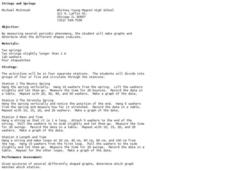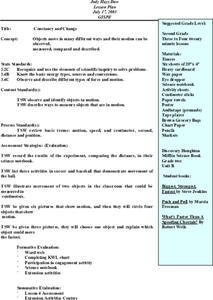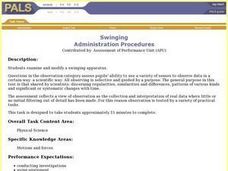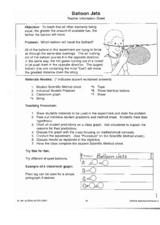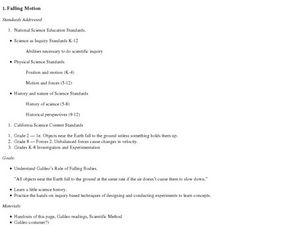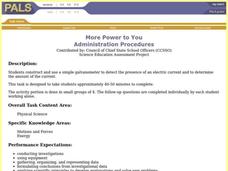Curated OER
Changing Ramp Heights
Students conduct an experiment to determine how the change in ramp height affects the distances a ball is able to move a stationary cup. Data is collected from several trials and recorded and analyzed.
Curated OER
Multimedia to Learn Textbook Science
Pupils work in cooperative groups to produce multimedia presentations to explain how the movement of a yo-yo. Students research information about force and motion and relate it to the movement of the yo-yo.
Curated OER
Strings and Springs
Ninth graders explore physics with springs and strings. In this force and motion lesson, 9th graders rotate through four stations exploring how various springs stretch and bounce, and how mass and length affect a pendulum's swing. They...
Curated OER
1994 -B No. 1: Velocity and Density
In this physics worksheet, students solve a variety of problems regarding velocity, density, mass, force, friction, and motion by utilizing high-level mathematical skills.
Curated OER
Motions and Forces
Sixth graders investigate the construction of a magnet and the force it produces. They identify various materials as magnetic or non-magnetic, discuss the properties of magnetic properties, and conduct an experiment with a compass and...
Alabama Learning Exchange
Investigating Friction
Young learners explore friction. They view a video or DVD (bibliography provided) and define terms related to friction, and work in groups to experiment with the effects of friction on speed and motion using ramps and toy cars.
Curated OER
Ahimsa as a Moral Force
Students explore the concept of Ahimsa. In this peace and tolerance lesson plan, students discuss Gandhi's application of Ahimsa and Satyagrah as they view the motion picture titled, "Gandhi." Students also discuss how effective...
Curated OER
Simple Harmonic Motion
Students explain the theory of simple harmonic motion (SHM) by performing hands-on, practical application experiments.
Curated OER
Marvelous Magnets
Students identify and classify magnetic and nonmagnetic materials and metals. After determining which materials and metals are magnetic, students create a data table and classify items by two different criteria. Students e-mail various...
LABScI
Viscosity: The Fluid Lab
There's more to fluids than meet the eye—they include gases, liquids, and polymers, too! Scholars complete three hands-on activities exploring different properties of fluids. They explore viscosity by measuring the resistance, or...
Purdue University
Slow Boat Design
Don't be a drag. Learners work in groups to design boats that move slowly. The provided reason for the activity is that a fish caught on a fishing reel is pulling the boat, causing it to move too fast. The STEM activity teaches the class...
Curated OER
Rockets!!
Learners launch a rocket. In this laws of motion lesson, students discuss the forces of flight, how a plane flies and how a rocket gets off the ground. Learners watch a video about rocket launches, discuss Newton's Third Law...
Curated OER
Design Your Own Rube Goldberg Machine
Students participate in a culminating activity for a unit on Energy and Simple Machines. They are challenged to incorporate simple machines in to a complex mechanical system. While designing and testing their machine they will also...
Curated OER
Constancy and Change
Second graders investigate how objects can move in different ways. They move in different ways across the room and develop a class list of movement words. Students also conduct a measuring motion experiment, create a bar graph for the...
Curated OER
Parachutes: What a Drag
Sixth graders make 2 different kinds of parachutes and record and graph the time for each one for the different drag forces. In this parachute lesson plan, 6th graders compare the results to the rest of the class of each parachute and...
Curated OER
Swinging Observations
Students build a pendulum type swinging apparatus and make specific and selective observations using what they know about scientific observations. They look for regularities of movement, patterns, and systemic changes over time.
Curated OER
VECTORS
Ninth graders explore vectors. In this vectors lesson students complete a lab activity.
Curated OER
Extreme Acceleration
Students explore the concept of acceleration. They determine the acceleration rate of a roller-blader and graph the results.
Curated OER
Forces in a Climb
Students use a NASA website to use a given formula to find acceleration and distance after a specific time and how it relates to engine propulsion.
Curated OER
Soda Straw Rocket Activity
Students construct a rocket using soda straw. In this physics lesson, students determine the nose cone length that produces the best rocket. They explain the importance of using a control in an experiment.
Curated OER
Balloon Jets
Students investigate how fuel amount affects the distance traveled by balloons. In this physics lesson, students collect data and create a pictograph. They interpret data and formulate a conclusion.
Curated OER
Falling Motion
Students design and conduct an experiment on Galileo's Rule of Falling Bodies. In this physics instructional activity, students collect and analyze data. They create a presentation and share it with the class.
Curated OER
Calibrating a Roverbot
Students build and program a Lego Mindstorms Roverbot to travel for a given amount of time. They gather data on time versus distance traveled to determine a calibration constant for their robot, which relates time to distance.
Curated OER
More Power to You
Students construct a simple galvanometer in order to detect the presence of an electric current as well as determine the amount of the current. Activity is divided into two parts, first part as group work and second as individual.
Other popular searches
- Elementary Force and Motion
- Force and Motion Experiments
- Science Force and Motion
- Motion and Force
- Unbalanced Force and Motion
- Force and Motion Activities
- Force and Motion Unit
- Force Motion Energy
- Force and Motion Lessons
- Science Force Motion
- Force Motion and Energy
- Motion Force and Gravity


